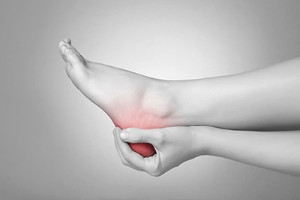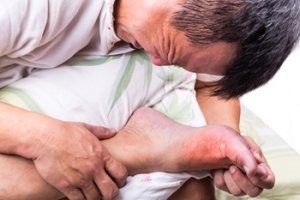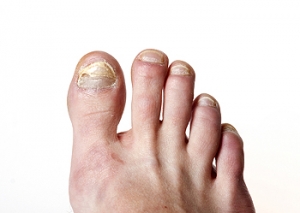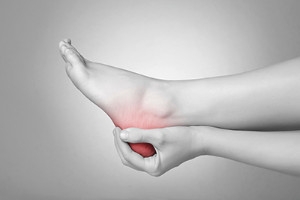
Arthritis Can Cause Pain in the Feet and Ankles
Why Is My Child Limping?
 Active children who enjoy participating in running and jumping activities like basketball and gymnastics may be prone to developing Sever’s disease. This is a condition that affects the growth plate in the heel of children and young teenagers and can cause severe pain and discomfort. It may happen as a result of the foot bones growing faster than the tendons, which increases the tension on the heel. Symptoms that children notice can include severe heel pain which may be worse upon arising in the morning, and it may be difficult to walk and run. It is beneficial to temporarily stop the activity that caused this condition, and mild relief may be found when the affected foot is elevated. If you notice your child is limping or walking on their tiptoes, it is suggested that you schedule an appointment with a podiatrist who can effectively diagnose and treat Sever’s disease.
Active children who enjoy participating in running and jumping activities like basketball and gymnastics may be prone to developing Sever’s disease. This is a condition that affects the growth plate in the heel of children and young teenagers and can cause severe pain and discomfort. It may happen as a result of the foot bones growing faster than the tendons, which increases the tension on the heel. Symptoms that children notice can include severe heel pain which may be worse upon arising in the morning, and it may be difficult to walk and run. It is beneficial to temporarily stop the activity that caused this condition, and mild relief may be found when the affected foot is elevated. If you notice your child is limping or walking on their tiptoes, it is suggested that you schedule an appointment with a podiatrist who can effectively diagnose and treat Sever’s disease.
Sever's disease often occurs in children and teens. If your child is experiencing foot or ankle pain, see one of our podiatrists from Cascade Foot Clinic. Our doctors can treat your child’s foot and ankle needs.
Sever’s Disease
Sever’s disease is also known as calcaneal apophysitis, which is a medical condition that causes heel pain I none or both feet. The disease is known to affect children between the ages of 8 and 14.
Sever’s disease occurs when part of the child’s heel known as the growth plate (calcaneal epiphysis) is attached to the Achilles tendon. This area can suffer injury when the muscles and tendons of the growing foot do not keep pace with bone growth. Therefore, the constant pain which one experiences at the back of the heel will make the child unable to put any weight on the heel. The child is then forced to walk on their toes.
Symptoms
Acute pain – Pain associated with Sever’s disease is usually felt in the heel when the child engages in physical activity such as walking, jumping and or running.
Highly active – Children who are very active are among the most susceptible in experiencing Sever’s disease, because of the stress and tension placed on their feet.
If you have any questions, please feel free to contact our offices located in Bend and Redmond, OR . We offer the newest diagnostic and treatment technologies for all your foot and ankle injuries.
Sever's Disease
Sever’s disease, also known as calcaneal apophysitis is a common bone disorder that occurs during childhood. The disease is defined as an inflammation of the growth plate in the heel. When a child has a growth spurt, his heel bone grows faster than the muscles, tendons, and ligaments in his leg. This disease is a result of overuse. The people who are most likely to be affected by this disease are children who are in a growth spurt, especially boys who are from the ages of 5 to 13 years old. 60% of children with Sever’s disease have both heels involved.
Symptoms of this disease are heel pain that intensifies during running and jumping activities. The pain is typically localized to the posterior part of the heel. Symptoms may be severe, and they can easily interfere with daily activities. Children who play soccer, baseball, and basketball are more likely to develop Sever’s disease.
Your doctor will diagnose your child based on his or her symptoms, x-rays are generally not helpful in diagnosing this disease. Your doctor may examine both heels and ask your child questions about his or her activity level in sports. Your doctor may then use the squeeze test on your child’s heel to see if there is any pain. Nevertheless, some doctors might still use x-rays to rule out any other issues such as fractures, infections, and tumors.
Sever’s disease can be prevented by maintaining good flexibility while your child is growing. Another prevention method is to wear good-quality shoes that have firm support and a shock-absorbent sole. Sever’s disease can be treated by ceasing any activity that causes heel pain. You should apply ice to the injured heel for 20 minutes 3 times a day. Additionally, orthotics should be used for children who have high arches, flat feet, or bowed legs.
If you suspect your child has Sever’s disease, you should make an appointment with your podiatrist to have his or her foot examined. Your doctor may recommend nonsteroidal anti-inflammatory drugs (NSAIDs), such as ibuprofen or naproxen to relieve pain. In more severe cases, your child may need a cast to rest his or her heel. Fortunately, Sever’s disease does not cause long-term foot problems. After treatment, your child should start to feel better within two weeks to two months.
What Can Cause Gout?
 Patients with gout are often aware of the intense pain and discomfort this condition may cause. It is an arthritic ailment that generally affects the joints in the big toe, and can cause difficulty in walking. It quickly develops as a result of excess uric acid levels in the blood, which can be caused by high amounts of purines. These are found in the foods that are eaten, and can include red meat, shellfish, and drinks that have a large amount of sugar, including alcohol. Additionally, people who have elevated cholesterol levels, kidney disease, or are overweight may be prone to developing gout. It is strongly suggested that you are under the care of a podiatrist when gout attacks are experienced.
Patients with gout are often aware of the intense pain and discomfort this condition may cause. It is an arthritic ailment that generally affects the joints in the big toe, and can cause difficulty in walking. It quickly develops as a result of excess uric acid levels in the blood, which can be caused by high amounts of purines. These are found in the foods that are eaten, and can include red meat, shellfish, and drinks that have a large amount of sugar, including alcohol. Additionally, people who have elevated cholesterol levels, kidney disease, or are overweight may be prone to developing gout. It is strongly suggested that you are under the care of a podiatrist when gout attacks are experienced.
Gout is a painful condition that can be treated. If you are seeking treatment, contact one of our podiatrists from Cascade Foot Clinic. Our doctors will treat your foot and ankle needs.
What Is Gout?
Gout is a form of arthritis that is characterized by sudden, severe attacks of pain, redness, and tenderness in the joints. The condition usually affects the joint at the base of the big toe. A gout attack can occur at any random time, such as the middle of the night while you are asleep.
Symptoms
- Intense Joint Pain - Usually around the large joint of your big toe, and it most severe within the first four to twelve hours
- Lingering Discomfort - Joint discomfort may last from a few days to a few weeks
- Inflammation and Redness -Affected joints may become swollen, tender, warm and red
- Limited Range of Motion - May experience a decrease in joint mobility
Risk Factors
- Genetics - If family members have gout, you’re more likely to have it
- Medications - Diuretic medications can raise uric acid levels
- Gender/Age - Gout is more common in men until the age of 60. It is believed that estrogen protects women until that point
- Diet - Eating red meat and shellfish increases your risk
- Alcohol - Having more than two alcoholic drinks per day increases your risk
- Obesity - Obese people are at a higher risk for gout
Prior to visiting your podiatrist to receive treatment for gout, there are a few things you should do beforehand. If you have gout you should write down your symptoms--including when they started and how often you experience them, important medical information you may have, and any questions you may have. Writing down these three things will help your podiatrist in assessing your specific situation so that he or she may provide the best route of treatment for you.
If you have any questions, please feel free to contact our offices located in Bend and Redmond, OR . We offer the newest diagnostic and treatment technologies for all your foot care needs.
Gout
Gout is a form of arthritis that is caused by a buildup of uric acid crystals in the joints. This considered to be one of the most frequently recorded medical illnesses throughout history. Gout occurrences in the US have risen within the past twenty years and the condition now affects 8.3 million people which is 4% of all Americans. Researchers have found that gout affects men more than women and African-American men more than white men.
Symptoms of gout are warmth, swelling, discoloration, and tenderness in the affected joint area. The small joint on the big toe is the most common place for a gout attack to occur.
People who are obese, gain weight excessively, drink alcohol heavily, have high blood pressure, or have abnormal kidney function are more likely to develop gout. Furthermore, certain drugs and diseases are likely to increase levels of uric acid in the joints which eventually leads to gout. You are also more likely to develop gout if you eat a lot of meat and fish.
Many who experience gout attacks will experience repeated attacks over the years. Some people who have gout symptoms, may never have them again, but others may experience them several times a year. If you have gout symptoms throughout the year, you may have recurrent gout. Those who have gout should also be careful about their urate crystals collecting in their urinary tract, because this may lead to kidney stones.
Diagnosis for gout is done by checking the level of uric acid in the joints and blood. Your podiatrist may also prescribe medicine to reduce uric acid buildup in the blood, which will help prevent any gout attacks.
To treat gout, your podiatrist may also prescribe you Anti-inflammatory medication (NSAIDs) which will relieve the pain and swelling of a gout episode and it can also shorten a gout attack. Maintaining a healthy diet is also a proven method to prevent gout attacks.
Environments Toenail Fungus May Be Found
 Toenail fungus is a common ailment around the world. The symptoms that many patients experience include yellow, thickened, and brittle toenails. Toenail fungus is contagious, and it is caused by a fungus that lives and thrives in warm and moist environments. These can consist of shower room floors, public swimming pools, and surrounding areas. Possible prevention methods can include wearing appropriate shoes while frequenting these areas, and it is important to refrain from sharing shoes, socks, and towels. If you have developed this condition, it is suggested that you speak with a podiatrist who can discuss treatment options with you.
Toenail fungus is a common ailment around the world. The symptoms that many patients experience include yellow, thickened, and brittle toenails. Toenail fungus is contagious, and it is caused by a fungus that lives and thrives in warm and moist environments. These can consist of shower room floors, public swimming pools, and surrounding areas. Possible prevention methods can include wearing appropriate shoes while frequenting these areas, and it is important to refrain from sharing shoes, socks, and towels. If you have developed this condition, it is suggested that you speak with a podiatrist who can discuss treatment options with you.
For more information about treatment, contact one of our podiatrists of Cascade Foot Clinic. Our doctors can provide the care you need to keep you pain-free and on your feet.
Toenail Fungus Treatment
Toenail fungus is a condition that affects many people and can be especially hard to get rid of. Fortunately, there are several methods to go about treating and avoiding it.
Antifungals & Deterrence
Oral antifungal medicine has been shown to be effective in many cases. It is important to consult with a podiatrist to determine the proper regiment for you, or potentially explore other options.
Applying foot powder on the feet and shoes helps keep the feet free of moisture and sweat.
Sandals or open toed shoes – Wearing these will allow air movement and help keep feet dry. They also expose your feet to light, which fungus cannot tolerate. Socks with moisture wicking material also help as well.
If you have any questions please feel free to contact our offices located in Bend and Redmond, OR . We offer the newest diagnostic tools and technology to treat your foot and ankle needs.
Toenail Fungus
Toenail fungus is a frustrating problem that affects many people. It can be persistent and hard to get rid of. As many different types of fungi are present throughout the environment, it is very easy to contract toenail fungus.
The feet are especially susceptible to toenail fungus because shoes and socks create the ideal dark and moist environment that fungal infections thrive in. While fungal infections of the nail plate are quite common, if left untreated they can spread beyond the toenail and into the skin and other parts of the body.
Signs of toenail fungus include a thickened nail that has become yellow or brown in color, a foul smell, and debris beneath the nail. The toe may become painful due to the pressure of a thicker nail or the buildup of debris.
Treatment for toenail fungus is most effective during the early stages of an infection. If there is an accumulation of debris beneath the nail plate, an ingrown nail or a more serious infection can occur. While each treatment varies between patients, your podiatrist may prescribe you oral medications, topical liquids and creams, or laser therapy. To determine the best treatment process for you, be sure to visit your podiatrist at the first signs of toenail fungus.
Location of the Plantar Fascia
 Pain and discomfort often accompanies the foot condition that is known as plantar fasciitis. It can occur as a result of an inflamed plantar fascia, which is located on the bottom of the foot. The Plantar fascia is a portion of tissue that connects the heel to the toes and is crucial in completing basic foot movements. Plantar fasciitis can develop from standing on hard surfaces for extended periods of time throughout the day, overuse, or from a sudden weight gain. Common symptoms can include heel pain after arising in the morning and difficulty walking. It is beneficial to properly stretch the feet before and after exercising, as this may be helpful in preventing plantar fasciitis. If you are afflicted with this condition, please consult with a podiatrist to learn about treatment options.
Pain and discomfort often accompanies the foot condition that is known as plantar fasciitis. It can occur as a result of an inflamed plantar fascia, which is located on the bottom of the foot. The Plantar fascia is a portion of tissue that connects the heel to the toes and is crucial in completing basic foot movements. Plantar fasciitis can develop from standing on hard surfaces for extended periods of time throughout the day, overuse, or from a sudden weight gain. Common symptoms can include heel pain after arising in the morning and difficulty walking. It is beneficial to properly stretch the feet before and after exercising, as this may be helpful in preventing plantar fasciitis. If you are afflicted with this condition, please consult with a podiatrist to learn about treatment options.
Plantar fasciitis is a common foot condition that is often caused by a strain injury. If you are experiencing heel pain or symptoms of plantar fasciitis, contact one of our podiatrists from Cascade Foot Clinic. Our doctors can provide the care you need to keep you pain-free and on your feet.
What Is Plantar Fasciitis?
Plantar fasciitis is one of the most common causes of heel pain. The plantar fascia is a ligament that connects your heel to the front of your foot. When this ligament becomes inflamed, plantar fasciitis is the result. If you have plantar fasciitis you will have a stabbing pain that usually occurs with your first steps in the morning. As the day progresses and you walk around more, this pain will start to disappear, but it will return after long periods of standing or sitting.
What Causes Plantar Fasciitis?
- Excessive running
- Having high arches in your feet
- Other foot issues such as flat feet
- Pregnancy (due to the sudden weight gain)
- Being on your feet very often
There are some risk factors that may make you more likely to develop plantar fasciitis compared to others. The condition most commonly affects adults between the ages of 40 and 60. It also tends to affect people who are obese because the extra pounds result in extra stress being placed on the plantar fascia.
Prevention
- Take good care of your feet – Wear shoes that have good arch support and heel cushioning.
- Maintain a healthy weight
- If you are a runner, alternate running with other sports that won’t cause heel pain
There are a variety of treatment options available for plantar fasciitis along with the pain that accompanies it. Additionally, physical therapy is a very important component in the treatment process. It is important that you meet with your podiatrist to determine which treatment option is best for you.
If you have any questions, please feel free to contact our offices located in Bend and Redmond, OR . We offer the newest diagnostic and treatment technologies for all your foot care needs.
Plantar Fasciitis
Plantar fasciitis is one of the most common causes of heel pain. The plantar fascia is the thick band of tissue that connects the heel bone to the toes. When this band of connective tissue becomes inflamed, plantar fasciitis occurs. Fortunately, this condition is treatable.
There are several factors that may put you at a greater risk for developing plantar fasciitis. One of the biggest factors is age; plantar fasciitis is common in those between the ages of 40 to 60. People who have jobs that require them to be on their feet are also likely to develop plantar fasciitis. This includes factory workers, teachers, and others who spend a large portion of their day walking around on hard surfaces. Another risk factor is obesity because excess weight can result in extra stress being placed on the plantar fascia.
People with plantar fasciitis often experience a stabbing pain in the heel area. This pain is usually at its worst in the morning, but can also be triggered by periods of standing or sitting. Plantar fasciitis may make it hard to run and walk. It may also make the foot feel stiff and sensitive, which consequently makes walking barefoot difficult.
Treatment for plantar fasciitis depends on the severity of the specific case of the condition. Ice massage applications may be used to reduce pain and inflammation. Physical therapy is often used to treat plantar fasciitis, and this may include stretching exercises. Another treatment option is anti-inflammatory medication, such as ibuprofen.
If you suspect that you have plantar fasciitis, meet with your podiatrist immediately. If left untreated, symptoms may lead to tearing and overstretching of the plantar fascia. The solution is early detection and treatment. Be sure to speak with your podiatrist if you are experiencing heel pain.








